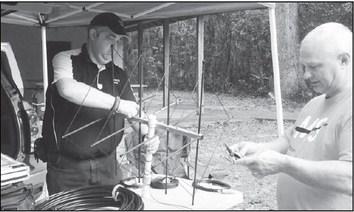For Clay County amateur radio operators emergencies come first
For Scott Roberts, assistant coordinator and public information officer for ARES, part of the hobby is all about being able to provide help when it is needed the most, he said.
“When storms hit, amateur radio operators will usually turn their radios on and begin to listen for any problem areas,” said Roberts.
Amateur radio operators then will use services such as SKYWARN, a national volunteer-based organization which helps keep local communities safe, he said. Operators get and give weather reports in their areas. Such reports are vital so rescue and emergency teams can operate under safety and assist those in need.
“If weather is severe enough, the EOC [Emergency Operations Center] will go to a heightened level and our radio operators will stand by and wait to see where they are needed,” Roberts said.
“According to the Amateur Radio License database, there are 922 licenses in Clay County, not all of them are active.” Roberts said.
He said that even local residents who are abroad and might need to communicate with loved ones “at home,” Hams might be able to assist.
“We’ve got what is called the national traffic system. And so, let’s use the Philippines for example. If a family member is in the Philippines, and they want to let their family know in the United States they’re doing fine, they would find someone that has a Ham radio and give them the message,” Roberts said.
Then Ham radio operators would start going through the air-wave motions, he said.
“That message would get transferred to probably California, because that’s how the radio waves would work, then that person in California would transfer that [message] to another radio in the United States and so on until it got to the destination. That radio operator would pick up the phone and deliver the message,” Roberts said.
Roberts said once the message gets to its destination, Ham operators are not done with their work.
“If a message wanted to be delivered back to the family, it would work in reverse,” Roberts said. from page 5
Roberts also said that old technology comes handy in case of a severe storm. Since Hams are mobile, they are able to take the equipment with them.
“Amateur radio does not rely on any conventional technology that we use today, such as cell phones, internet, and land lines,” Roberts said.
Even if power is down, Hams are able to come to the rescue, he said.
“We use radio waves and, therefore, can send messages regardless of these technologies. Since our equipment can run from a battery or generator, we do not rely on the power company,” Roberts said.
In case a storm hit Clay County, Roberts said, he is ready to provide assistance from home even without power. He said his radio equipment, together with a computer, is hooked to a battery and it may give him 24 hours of power to assist others.
“It depends on how many solar panels you have and how big your battery is,” Roberts said.
Jim Winfrey was an electronic maintenance chief in the military for 21 years. While Winfrey was responsible to fix and maintain equipment for military purposes, it was not long ago that he became a Ham himself.
“I was hands-on the radios … I have been an operator for three and a half years,” Winfrey said. Winfrey is proud of his Amateur Extra license and said since this is a well-regulated hobby, there are levels to apply, books to read, and tests to take when one becomes a Ham.
“There are three levels of amateur licenses. Technician class, and then general class, and then amateur extra,” Winfrey said. For Winfrey the hobby came as a natural fit. “I just grew up with it. My dad owned an audio visual store and I just played with the equipment.” Winfrey said.
Roberts knows services provided by him and Winfrey are no kid’s play. He realizes how vital these services can be and the impact they make in case of an emergency. “If the grid goes down and everyone loses the internet, and all cell phone coverage, this will be pretty much the only means of communication,” Roberts said.
Scott Roberts, left, and Jim Winfrey, right, set up a directional antenna for Hams in the Park in Fleming Island Saturday, Nov. 16. Radio enthusiasts from Clay County, Duval County, St. Johns County and Putnam County who were at the site from 8 a.m. to 1 p.m. showing the latest on mobile technology.

Scott Roberts turns a”go-kit”on. Roberts said the equipment is basically for a portable setup and used on a remote location. He also said that the go-kit will run on a 12 Volt battery or an outlet.
The original article can be found at the Clay Today Web site




 Facebook
Facebook FourSquare
FourSquare Skype
Skype Twitter
Twitter
Comments
For Clay County amateur radio operators emergencies come first — No Comments
HTML tags allowed in your comment: <a href="" title=""> <abbr title=""> <acronym title=""> <b> <blockquote cite=""> <cite> <code> <del datetime=""> <em> <i> <q cite=""> <s> <strike> <strong>